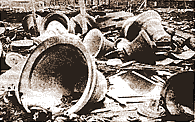The Founding of Liturgical Bells in Russia
 |
Let's face it: No Russian foundry survived even the early years of the Soviet Era, and the traditions of Russian bell-making were all but lost.
But this doesn't mean that Russia's new foundries had to start absolutely from scratch. There did in fact survive in Russia a traditional bell culture, a strong memory, not a few traditional bells (if only a fraction of those that existed before), a few bell teachers, and pockets of traditional bell-playing.
Thus despite the destruction in Russia there survived a sense of what an Orthodox bell is, and a knowledge of how to make one.
 |
As in so many other areas of Russian Christian culture, the thread is slim— but it didn't quite snap. We actually can say that our foundries pour a thousand years of tradition as well as the best of modern metallurgical and acoustical science into every bell they cast.
Moreover, competition among bell makers in Russia today is keen. Has someone produced a bell? Great news!— Now let hundreds of experts (to say nothing of whole populaces) critique and compare it to those of 36 other companies! Competition is keen, standards are high— and prices are competitive.
And Blagovest imports only from Russia's best foundries. From the top award winners at All-Russian bell festivals. Names like Pyatkov and Vera, ODMK, Litex, and Minsk.
Bells that win awards like "Best Sound", "Best Appearance", and "Best All-Around Excellence"– consistently, year after year.
The first thing to inspect
is the quality of the metal itself.
If you break a good bronze, you'll see something that looks like fine grains of sand.These grains are the crystallized tin and copper that will allow the bell to ring for a long time.
Of course, you're not going to break a chunk off a bell so you can see what metal it's made of. But you need to know whether the foundry casts bells only of pure bronze.
The exact proportions and specific procedures are the trade secrets of each foundry, although of course people have been making bronze since the 2nd millennium BC.
Generally, bell bronze is an allow of about 4 parts copper to 1 part tin, with impurities of less than 1%. Only this alloy will give you the powerful, rich, harmonious "zvon" and the durability of a Russian bell!
 |
But an important concern for every bell foundry is to ensure that absolutely no air bubbles or foreign matter in the metal when it is poured, as either would cause the bell to crack when struck repeatedly.
Some people imagine that silver is used in bell-founding. We even sing of "silver bells". But that's a myth. Silver would make the bell brittle, and a brittle bell would soon crack.
If you want to save a little money (not always very much!)— you can buy a bell made of brass or pewter— but the lead and zinc in these metals are not going to give you the same sound as pure bronze! (Just by saying the words "lead", "zinc", and "bronze" you'll get an idea of the difference.)
 |
Another option is iron— and it's easy to find used iron schoolbells or firehouse bells— but of course iron produces a clang rather than the rich resonances that come from bronze, and no iron bell is tuned. Its purpose is just to make a loud noise!
Russian Bells Are Different
Or again, you could buy your bells from a European company. Modern European bells are unquestionably of the highest quality. Nevertheless, even those that claim to have teamed up with Russian foundries do not actually observe the centuries-old traditioins of Orthodox bell-making. Essentially, they cast European bells with Russian inscriptions. And they are not familiar with the Russian approach to bell-ringing generally.
European bells are designed to suppress certain harmonics, and to enhance others in a way that's generally fit for carillons— which are essentially giant pianos. Russian bells, on the other hand, are cast for specific tones— and they achieve them— but they are more like drums, not melody instruments. For this reason, a certain "funkiness" is valued. Actually, what is valued generally in Orthodoxy is the "personal voice" of a thing, rather than its conformity to abstract production standards. That's what a bishop whose church has European bells was getting at when we were talking with him recently—"They're good," he said, "but their tuning is a little too precise for the Orthodox tradition."
What does all this mean, in terms of practical acoustics? Russian bells are cast for a tone, and finished when cast and not machine-tuned on a lathe, like their Western counterparts. Each has a particular, distinctive voice. That's why it can be said that you never forget the bells of your village, no matter how long you're away.
It's the distinctive, personal voice that makes a Russian bell an Orthodox bell.